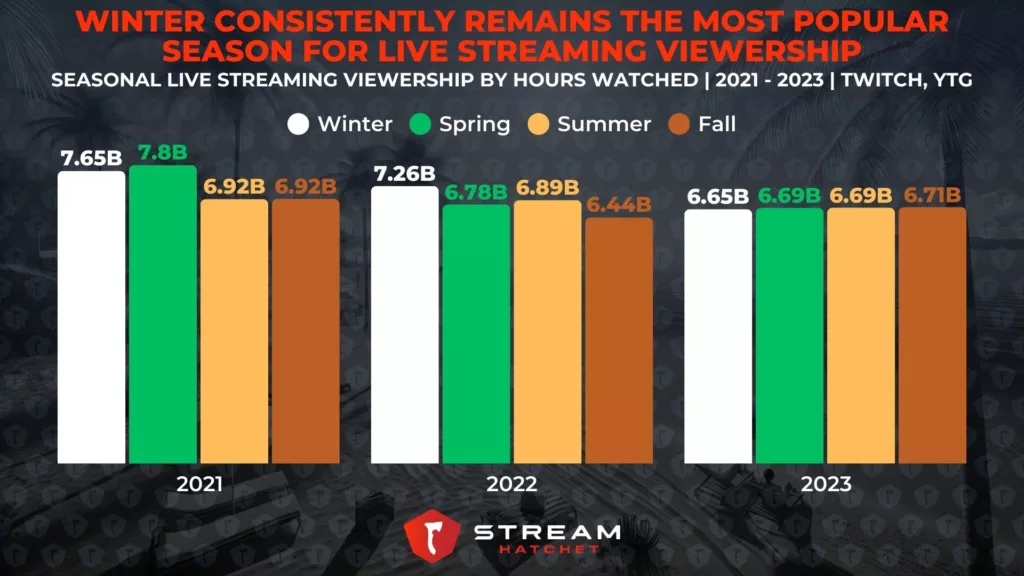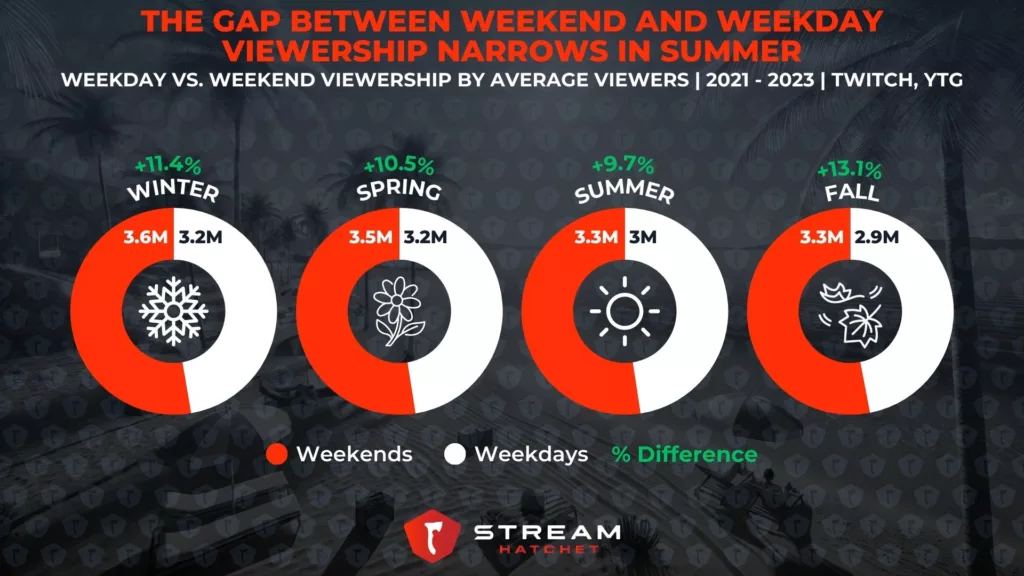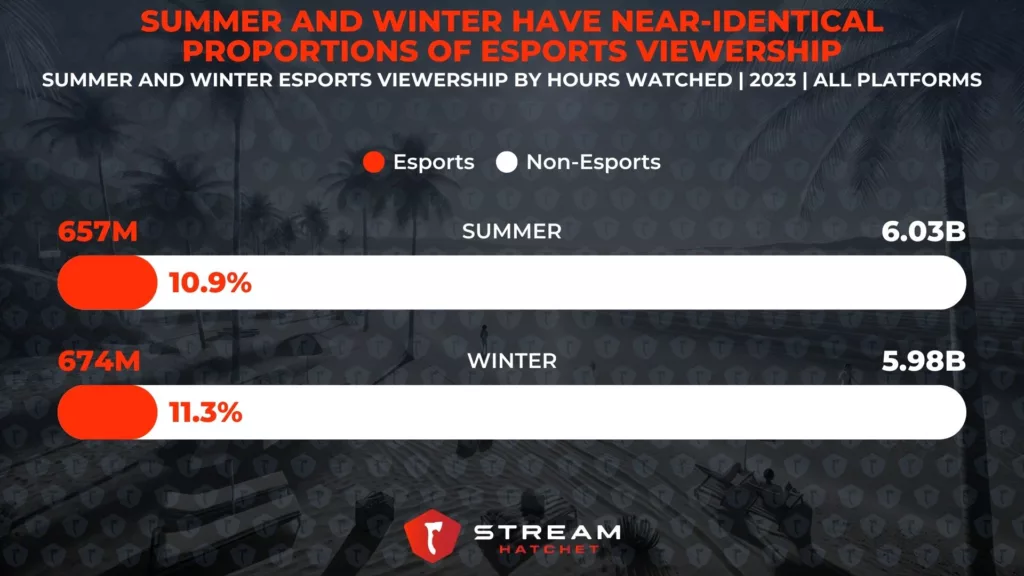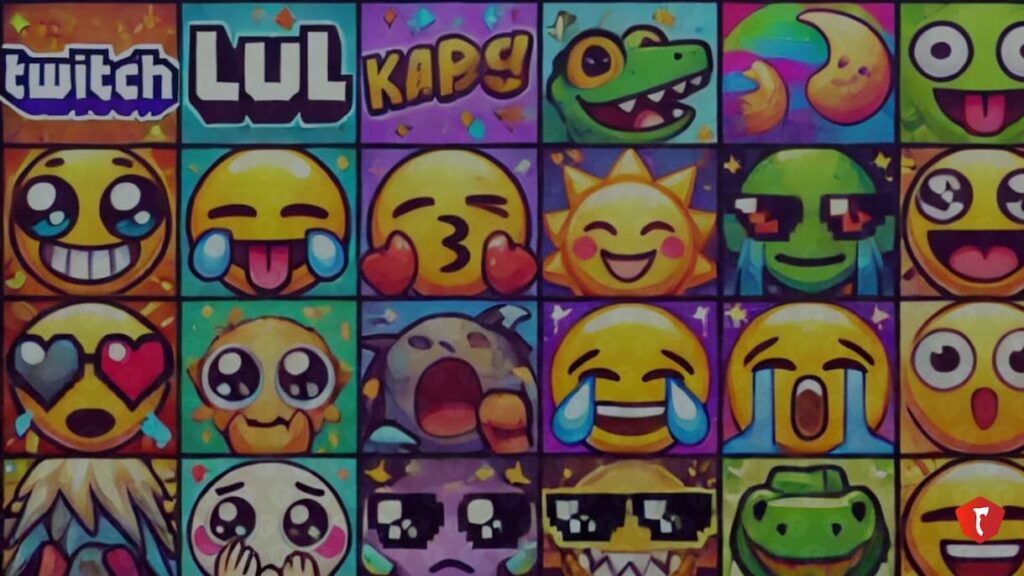As we move into the hottest part of the year, viewer habits on live-streaming platforms change. It behooves game publishers, sponsors, and event organizers to understand the difference in seasonal viewership so that they can schedule their game releases and tournaments strategically.
So far in June of 2024, we’ve seen two trends emerge in which games are being watched online. Mobile game viewership has risen, perhaps due to more people traveling and attempting to leave the computer off to stay cool. However, MMO viewership is up across the board, also suggesting that a separate faction of younger viewers are using their time off to invest in games with deep stories and mechanics. These specific trends, however, are emblematic of grand changes to live-streaming platform engagement that cyclically recur with the changing of the seasons.
In this article, we’ll be looking at how the warmer weather and calendar events affect live-streaming viewing habits on a seasonal level. This analysis focuses on the Northern Hemisphere’s seasons due to Asian, European, and North American markets most heavily impacting online viewership as a whole.
Seasonal Viewership Reveals Winter is More Popular Than Summer

Looking back over the past three years, certain seasonal trends emerge. In general, winter sees higher viewership than summer on live-streaming platforms, with both 2021 and 2022 having over 7B hours watched in winter. In concept, this makes sense: People want to be outside in summer or even on vacation and away from their creature comforts. In fact, according to Nielsen, traditional streaming also sees a downturn in viewership in the summer months (the lowest month being May).
However, the picture isn’t so clear-cut: In 2021, spring had the highest viewership with 7.8B hours watched – perhaps a hangover effect of COVID restrictions keeping viewers indoors. Additionally, summer 2023 had a slightly higher viewership than winter 2023 by 38M hours watched. Summer’s popularity may be bolstered by the non-E3 game showcases and special events like Summer Games Done Quick.
Summer Sees More Viewers Watching Live Streaming During Weekdays

During summer, another interesting trend emerges: Weekday average viewership is closer to weekend average viewership during summer than winter. In other words: Although winter weekend average viewership is 400K higher than winter weekday average viewership, this same gap narrows to just 300K for summer. It’s worth noting, however, that this data is drawn specifically from 2023.
This is a small but meaningful difference, suggesting that in the summer people spend less time on live-streaming platforms during the weekend. As mentioned before, this difference could be because viewers want to enjoy activities outside. However, there’s another likely reason: A change in streamers’ habits. Streamers also spend more time outside during the summer, which trends towards IRL and travel vlogging content. Both of these types of content are typically shorter than gaming streams (which can be marathon sessions). As such, there’s less content to consume for viewers.
Esports Viewership is Steady Across the Year, but Spikes on Weekends

Although the reason for these seasonal differences is difficult to discern, one explanation can be ruled out: Esports. Looking at summer and winter of 2023 reveals that the two seasons sourced an almost identical amount viewership from esports (10.9% and 11.3%, respectively). Both summer and winter feature massive esports events, with most leagues having both a winter and summer edition. Summer may be gaining traction, however: The Esports World Cup which launched its first edition in Saudi Arabia this year has been a roaring success and may buoy summer esports viewership in years to come.
One more interesting observation emerges when comparing weekday esports viewership against weekend esports viewership. In both summer and winter, esports contribute to the massive difference between weekday and weekend viewership. Looking at summer for example, there’s a roughly 10% difference between weekday and weekend viewership. This comes almost entirely from esports viewership, with non-esports contributing a difference of just 0.4%. In essence, this tells us that weekend viewership is overwhelmingly boosted by esports events – regardless of the season.
Still, however, summer viewership is down. More big summer events like Ibai’s La Velada del Año may help to rectify this difference, but it could also be worth looking elsewhere during summer. For example, the Southern Hemisphere is a growing market for live-streaming platforms: International brands, event organizers, and game developers could try focusing their attention on the Australian, South American and African markets during the Northern Hemisphere’s summer. Alternatively, sponsors might look to Stream Hatchet’s calendar of upcoming summer events to better utilize the summer months.
To keep up to date with the latest industry-wide trends on live-streaming platforms, follow Stream Hatchet:







